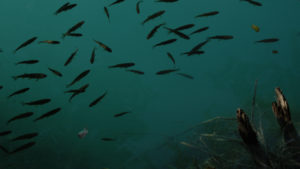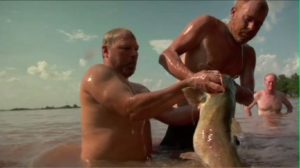The fishing rod may be the most commonly used tool by the modern angler when fishing for himself.
But that doesn’t mean that it is the only method to catch fish. In fact, there a lot of other more…. obscure methods not commonly known or used compared to the classic rod.
Why is that? It is likely because the fishing rod is convenient, easy, and allows you to stay on dry land the entire time, meaning that you will never get wet when fishing unless you accidentally slip and fall in. Some other methods are physically taxing in nature, and others rely on a lot of training to get right. You may also need to get down and wet too. All, however, can become invaluable methods, when given the right situation.
Being in a survival situation fits this bill. Getting a rod for the sake of “sport” won’t be always helpful in filling your belly in the coming days. Sometimes, it might be better to forego making one if there may be potentially other better methods that can be used and having as many options as possible can help you become more flexible.
With all that said, this article will examine what other fishing methods you can use that doesn’t involve a rod.
Spearfishing
A fishing method practically as old as humanity itself, spearfishing has been used by our ancestors for so long and can be dated all the way back to the paleolithic age, where fishing rods didn’t exist yet.
It is primitive but effective. The method is simple: With large and sharpened sticks, they spear fish in rivers and streams. While it all sounds simple in theory, it is something you will need a lot of practice in if you want to catch dinner this way.
Fish are slippery beings. They won’t just allow themselves to be skewered by some random land mammal, least of all one with an unsteady arm.
While modern humans have a much higher intelligence, our ancestors had much more rugged bodies, thanks to constantly having to fight for survival in primitive conditions. This gave them an advantage when hunting, allowing the regular prehistoric human to stick their spears in the water much faster and effective than most normal humans of today.
However, as mentioned earlier, it is not something you cannot do. You simply need enough practice and a lot of patience.
For spears, the bare minimum is having a long, sturdy, and sharp pointy object. Using materials like long branches from the trees surrounding you or saplings can easily achieve that. If you have a knife, you can fashion it to be even sharper (and make the wooden spear easier to grip too).
Or you can use your knife as the tip of your spear. That works too.
Wooden Fishing Weir
Here, you will be attempting to trap the fish. A wooden fishing weir is made by placing lots of stakes in a heart shape but with a funnel entrance at the bottom in front of a strong current of a body of water. How it works is that the trap allows water to pass through without issue, but fish get caught in the trap, as they are unable to swim faster than the current to escape. The size of your weir can vary depending on how big the river or stream is, but it is an easy way to catch a lot of fish without having to use a lot of energy in doing so.
Yes, this strategy works for stones too, as long as you stack them high enough.
Noodling
Despite the silly name, this process does not involve any noodles. Not like you’ll find any in the wild anyway.
Noodling involves catching fish with your bare hands. Yes, you heard that right. Catching catfish by this method is its most common form, as it does not involve chasing after fish currently swimming upstream. (A very exhausting idea). To do this, you catch the catfish hiding in its shelter, which is usually under murky waters in craggy and rocky areas. You would stick your arm out as bait and let the catfish bite it.
For regular barehanded fishing, it is still possible to catch fish via the more traditional methods of simply trying to scoop them out of the water. To do so, you need to put your arms behind the fish (downstream, as fish tend to swim upstream for the most part) while also accounting for light refraction, slowly putting your hands around the fish, then pulling it out as fast as possible.
This is of course, very much easier said than done, and relies a lot of practice. Fishing barehanded should only ever be attempted in extreme circumstances, such as a lack of materials to build any kind of tool, as you risk injury (when being bitten by a catfish) or wasting energy (It is very hard for someone inexperienced to catch fish with their bare hands).
Whacking the fish
This seems like a joke, but it isn’t. All you need is a long cane from a sapling.
When you see any fish appear, you…. whack it as hard as you can. Yes, that really is all there is to it.
If it is still around, you try to hit it as much as possible until you manage to paralyze it.
There are better options, but this might help you in a pinch.
Improvised net
It is unlikely that you have any actual nets on hand to help you here. Lucky for you though, if you do not mind having a wet shirt for a while, you can use your clothes. If not, a blanket, or even a towel works just as well as long as you have two sticks as well.
Your targets are smaller fish, which are located in shallow water. Big fish are, well, too big to fit in your improvised net, and will likely be able to get away from you easily.
Simply chase the small fish into an inescapable corner and scoop them up quickly with your “net” to ensure that none of the small fishes manage to escape.
Conclusion
It is true that fishing can be considered a relaxing sport, when you have a rod in hand, but that does not apply to all situations, like a survival one.
In this scenario, you want to use all resources on hand to ensure your survival and being able to utilize methods to fish other than a regular fishing rod can help you.



